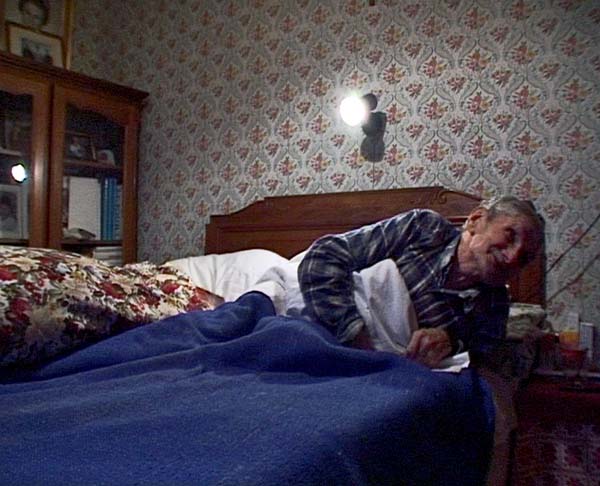[Écritures documentaire] Jean-Pierre Rehm
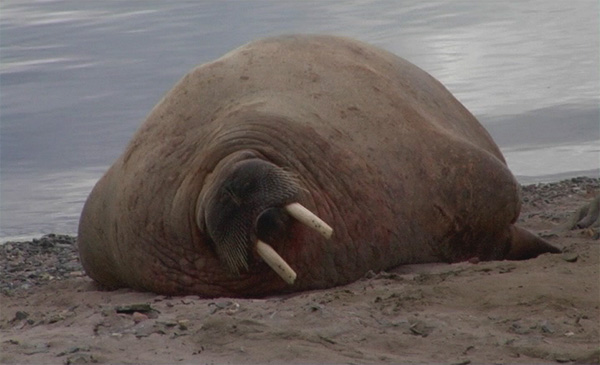
« Ce qui s’offre aujourd’hui, c’est le monde »
Entretien avec Jean-Pierre Rehm, critique d’art et directeur du FID, festival international du documentaire de Marseille.
Propos recueillis par Emmanuelle Lequeux.
Emmanuelle Lequeux : Vous dirigez depuis dix ans le festival du film documentaire de Marseille, le FID, que vous avez ouvert à toutes les formes de cinéma, ce qui fait de vous un observateur privilégié des liens entre arts plastiques et documentaire. Quand est-ce que, selon vous, art et cinéma ont commencé à imaginer des alliances possibles ?
Jean-Pierre Rehm : On prend trop souvent le problème par le biais de l’art, or il faut aussi le prendre par le biais du cinéma afin de comprendre pourquoi le documentaire n’est pas un genre, mais un champ d’exploration. Il est essentiel aussi de revenir aux films des avant-gardes des années 20, car c’est à ce moment là que tout se joue décisivement, notamment quand certains artistes russes, Dziga Vertov en tête, font le choix du cinéma plutôt que de la photo ou de la peinture. Ce dernier définit son film mythique, L’homme à la caméra, comme « un film sans » : sans acteur, sans décor, sans théâtre… C’est primordial : alors que les avant-gardes choisissent le cinéma de façon maximaliste, expressive, comme Eisenstein désireux de combiner tous les arts, Vertov décide de priver le cinéma du cinéma. Il ampute. Son cinéma est moins minimal que blessé, amputé des puissances du cinéma auxquelles il substitue d’autres ressources.

Ariane Michel Sur la Terre, 2005. Vidéo DV, beta & dvd, 13 min., son stereo / stereo sound. Courtesy galerie Jousse Entreprise.
E. L. : Vertov versus Eisenstein, vous voyez donc dès les années vingt deux tendances se dessiner ?
J-P. R : Le coup d’envoi de Vertov est double et décisif. D’abord parce que la provenance, c’est l’art, pas le cinéma, nourrie de la réflexion des avant-gardes pour atteindre un plus large public, parler du monde. Ensuite parce que dès sa naissance, le documentaire est avant tout démuni. Privé de. Ce qu’on appelle le réalisme, qui est la vocation du documentaire dans la lignée de Courbet, se fait dans cette enceinte très réduite, d’abord sous le signe du manque. Étonnamment, Vertov cherche une autodéfinition du cinéma, en un geste typiquement moderniste. Ce qui m’amène à dire que l’essence du cinéma réside dans cette pauvreté.
Ces films des avant-gardes avaient pour spécificité de se vouloir outil de propagande. Comment allier des préoccupations formalistes à ce désir de porter la parole politique ?
Il y a effectivement un paradoxe, que je ne saurais résoudre. Les cinéastes allemands combattent le fléau du nazisme, les russes font la promotion de leur révolution. Sur ces deux scènes, le politique requiert, exige, une efficacité qui se définit très vite comme articide. Brecht clamait qu’il faut tuer l’ambiguïté, cette expression typique de la petite bourgeoisie. Vertov a eu la volonté d’obéir à ses dictateurs, mais il a très vite rencontré des problèmes.
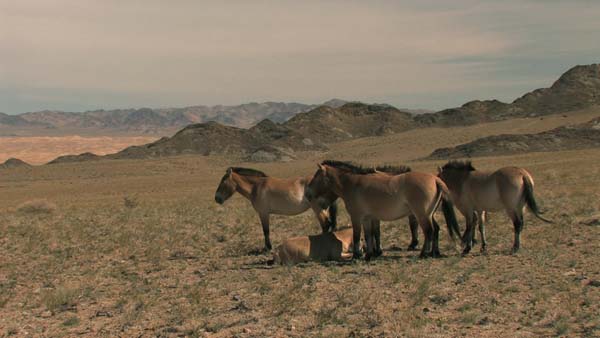
Ariane Michel La Ligne du dessus, 2010. Quadriptyque vidéo / 4 channel video installation. 4 projections HD synchronisées, son, 24 min. / 4 HD projections, synchronized, with sound, 24 min. Production Espace Croisé, Roubaix, avec le soutien de l’association Takh / Produced by Espace Croisé with the support of Takh. Courtesy galerie Jousse Entreprise.
Évoquons maintenant le deuxième temps fort du documentaire, les années soixante et soixante-dix, où prévaut là encore la parole politique.
Dans ces années de lutte, le programme avant-gardiste d’une certaine efficacité politique semble avoir gagné et nombre de films massifs au message clair sont alors produits, qui excluent l’art de leur problématique. Le cinéma documentaire se nourrit alors d’un héritage dégradé des avant-gardes, prônant un cinéma pour tous et très clair. Beaucoup de gens, comme les ouvriers du groupe Medvekine, apprennent sur le tas à se servir d’une caméra. Il s’agit avant tout de faire passer un message. C’est de l’artisanat pris dans l’urgence. Cela a entrainé une clôture du genre, qui est allé jusqu’à s’opposer très fermement à la fiction, selon eux dans les mains de l’imaginaire capitaliste. Il faudrait évoquer aussi le cinéma britannique des années cinquante, le fameux cinéma d’observation scientifique avec ces choses horribles comme de regarder l’évolution d’un enfant à 7, 17, 27 ans. Mais ce n’est pas très intéressant.
Comment considérez-vous le cas de Godard, qui se met au début des années soixante-dix à produire des documentaires ?
On dit toujours que Godard a une approche documentaire quand il réalise des fictions comme la Chinoise, mais au fond je suis persuadé qu’il n’aime pas vraiment ça. Le moment où il réalise des documentaires correspond à un moment où le tarabuste le désir d’échapper au fardeau d’être artiste. Il veut se débarrasser de lui-même, sans trop y parvenir. Pour moi il n’est pas du tout documentariste, c’est juste un cuisinier génial qui a le plus profond respect des ingrédients.
Une des particularités de Godard est d’avoir travaillé pour la télévision, ce qui serait inimaginable aujourd’hui.
À l’époque, la télévision de l’ORTF est là pour accomplir le programme de l’avant-garde ! C’est très troublant. Au moment où les luttes s’éteignent au cœur des années soixante-dix, le cinéma se trouve avec plein de bras et plus d’emploi : la télévision apparaît et s’ouvre à tous. Comme l’écrit Serge Daney dans Le salaire du zappeur, il y a là un espace possible, qui n’est pas si indigne. En revanche, le cinéma expérimental qui s’est trouvé devant le butoir du cinéma commercial n’a pas, lui, accès à la télévision. Il se construit alors une forteresse.
Venons-en à la situation contemporaine. Aujourd’hui, beaucoup de plasticiens sont attirés par les moyens et l’imaginaire du cinéma, et la réciproque est également vraie. Comment évaluer ces allers-retours ?
Aujourd’hui l’évolution vient des deux côtés. Depuis la Documenta X en 1997, voire l’exposition de Chantal Akerman au Jeu de Paume en 1995, un vrai coup d’envoi a été donné : les cinéastes accèdent à l’espace d’exposition. Du côté de l’art, il y a une certaine défiance : jusqu’au milieu des années quatre-vingt dix, aucun artiste ne s’affrontait à la question du documentaire. Les repères sont aussi brouillés par des gens comme Harun Farocki qui se considèrent comme cinéastes et non artistes. Ce dernier raconte souvent qu’il a deux types de problèmes : répondre pendant des débats à des questions posées par les gens de cinéma, qu’il trouve débiles, et répondre à des questions posées par les gens de l’art, qu’il ne comprend pas. La rupture entre ces deux mondes reste significative : des plasticiennes comme Ariane Michel, Clarisse Hahn ou Marie Voignier n’ont pas fait d’école de cinéma et ont des références cinématographiques assez approximatives. C’est la réduction des coûts de tournage et la maniabilité nouvelle des outils qui leur ont permis de faire un pas vers le cinéma. Quant aux cinéastes, ils cherchent des alternatives économiques dans les galeries, qui s’emparent de leurs objets sans trop savoir qu’en faire, comme Marian Goodman qui travaille avec Pedro Costa et Wang Bing, deux cinéastes qui ont une pratique documentaire.
Doit-on considérer qu’en s’exposant ainsi dans les centres d’art et musées, les cinéastes du documentaire renouvellent leur regard, ou que les œuvres y perdent en puissance ?
J’ai beaucoup de doutes sur ces gens du documentaire qui se risquent à l’art, de Kiarostami à Atom Egoyan, même si leurs mauvaises expositions ne discréditent pas du tout leur objet film. Ils essaient de faire des accrochages mais ne connaissent ni l’histoire de la sculpture ni celle de la vidéo, et bien souvent ils réinventent la lune. Leur intérêt est avant tout économique. Mais après tout, peu m’importe que l’exposition d’Apichatpong Weerasethakul au MAMVP n’ait pas été renversante : elle lui a permis de produire sa palme d’or, et c’est l’essentiel. C’est peut-être difficile à croire, mais Akerman a énormément de mal à financer ses films. Même chose pour Oliveira. Cependant, il faut reconnaître que le monde de l’art relève aussi pour eux du fantasme. Chris Dercon me racontait récemment qu’il voulait montrer un film de Straub et Huillet sur Cézanne à côté d’une toile de Cézanne. Je lui ai dit trouver son idée idiote. Mais il m’a rétorqué que Straub, quand il l’a appris, avait les larmes aux yeux : pour eux, intégrer l’espace du musée, c’est revenir sur cette blessure initiale dont je parlais au sujet de Vertov, vers cet art dont ils ont été privés. C’est une vieille douleur, très ancienne : dans tous les films de qualité, on peut déceler ce renoncement, ce vœu de pauvreté. Et soudain on les ramène vers les riches !
Vous évoquez cette pauvreté comme éthique et esthétique, mais aussi au sens strict, de manque de moyens ?
Au FID, un jour, j’ai décidé de mettre dans la même compétition fiction et documentaire : Weerasethakul contre Patricio Guzman. Ce dernier, grand réalisateur chilien, m’a dit : « tu nous a tendu un traquenard, ce n’est pas possible de juger les deux en même temps car la fiction a plus d’argent que nous ». Je lui ai répondu : « Mes fictions valent cinquante fois moins que tes films » ! Lui peut avoir des budgets de 700 000 euros, quand je montre des longs métrages à 12 000 ! Mais il demeure un puritanisme monacal attaché à ce champ de la création, c’est indécrottable. Et avec cette pauvreté vient un moralisme qui continue à se défier de l’espace de l’art et des ambigüités qu’il porte.
Comment analysez-vous en retour l’entrée progressive des plasticiens dans le champ du cinéma ?
Les gens de l’art n’ont, eux, pas peur, même s’ils réalisent eux aussi des objets pauvres. Clarisse Hahn ou Noëlle Pujol n’ont pas peur du luxe artistique. Ces jeunes artistes méconnaissent le documentaire, mais, et c’est plus important, ils savent décortiquer Coppola. Ce qui leur apporte un vocabulaire plus riche que s’ils se nourrissaient uniquement de Chris Marker, Johan Van der Keuken ou Frederick Wiseman : le cinéma joue davantage avec le cinéma.
Comment expliquer qu’après des années d’indifférence, tant d’artistes s’affrontent à la question du cinéma documentaire ? Que cherchent-ils dans ce champ que l’art ne saurait leur offrir ?
Je n’ai aucune assurance à le dire, mais j’ai l’impression que ce qui les excite est l’accès possible à une plus grande complexité, l’envie de richesse. Pendant des années, dans les décennies quatre-vingt et quatre-vingt dix, le cinéma documentaire a été pourri par le cancer narcissique. Les outils étaient devenus si simples que l’on se trouvait devant un seul sujet possible : soi-même, ou sa grand-mère. Heureusement, nous nous sommes débarrassés de tout cela. Ce qui s’offre aujourd’hui, c’est le monde. Les artistes l’évoquent avec une diversité extrême, dans une mosaïque de propositions très variées, et c’est ce qui me passionne. Tous ces films ont une économie très réduite, de 2 000 à 30 000 euros, dont aucun documentariste pur et dur ne voudrait. Cela peut être positif : le cinéma est le seul art où tout se voit, même et surtout l’argent.
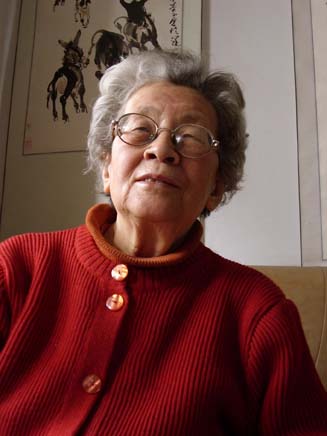
Wang Bing Fengming, chronique d’une femme chinoise, 2009. Film HD couleur 16/9e transféré sur DVD, son, 230 min. / HD film, color, 16:9, sound, DVD.
La génération des Huyghe, Parreno, Gonzalez-Foerster a été pionnière dans ses rapprochements avec le cinéma. Comment évaluez-vous leurs objets filmiques ?
J’ai beaucoup d’estime pour leur travail. Pour eux, un film est à chaque fois l’occasion d’aiguiser une question. J’ai beaucoup apprécié la stratégie du Zidane de Philippe Parreno et Douglas Gordon, car ils ont vraiment réfléchi à la logique tripartite production-tournage-diffusion. Voir ce DVD à la Fnac en tête de gondole, ça c’est de l’avant-garde !
Pourquoi les cinéastes expérimentaux restent-ils enfermés dans leurs propres frontières sans participer du tout à ce débat ?
Le champ du cinéma expérimental estime avoir assez souffert comme ça et n’est pas désireux d’ouvrir toutes les vannes. S’ils s’ouvrent, ils se dissolvent. De toute façon je trouve leur production actuelle très académique.
Ces interventions de plasticiens dans le champ documentaire provoquent-elles un renouvellement du genre ?
Il n’y a pas renouvellement, mais affutage. Ces gens amènent l’ambiguïté, la sophistication, la modestie, une vraie puissance d’étonnement, sans pataugas. Surtout, ils sont confiants dans le fait que le film parle plus que ce que l’on pourrait en dire. Quant à la tradition stricte du documentaire, elle est aujourd’hui cloisonnée aux débats télé sur la peine de mort ou la pollution. Heureusement, il y a des cinéastes comme Arnaud des Pallières qui savent ce qu’est la complexité. Le milieu de l’art a tendance à croire que la complexité, c’est Johan Grimonprez, dont il s’empare comme d’une merveille : moi je trouve ça chichi, c’est de la sophistication à portée de main ; c’est brillant, mais cela me laisse froid. La simplicité des moyens permet selon moi plus de complexité de la pensée.
Vous aimez évoquer l’idée de films idiomatiques. Les artistes français ont-ils selon vous une particularité de regard ?
La spécificité française depuis toujours, c’est cet art très élaboré de filmer la parole, de Jean-Charles Hue à Marie Voignier.
Si on les compare à l’hétérodoxie documentaire, qu’apportent ces plasticiens qui souvent font partir la réalité vers une sorte d’onirisme, comme le Pont du trieur de Charles de Meaux et Philippe Parreno que l’on pourrait qualifier de « documensonge » ?
Je parlerais plutôt d’étrangeté, ou de féérie. Dans sa Chronique d’une femme chinoise, Wang Bing filme une femme qui raconte sa vie dans les camps de redressement. La caméra ne s’arrête jamais, même quand elle va pisser, et tout d’un coup quand le jour est tombé, on se retrouve face à un écran noir. C’est énorme. C’est comme si tout ce film avait pour centre ce moment où l’on ne voit plus rien et où l’on entend parler. Pour moi c’est une féérie sans poésie, c’est le noir de l’horreur. Une horreur que l’on peut faire émerger quand l’on ne voit plus rien à l’écran. Cette femme, c’est la nuit de l’histoire.
‘What is offered today is the world”
Interview with Jean-Pierre Rehm, art critic and director of the Marseille international documentary film festival [FID], conducted by Emmanuelle Lequeux.

Apichatpong Weerasethakul Exposition Primitive, 2009. Musée d’Art moderne de la Ville de Paris. Photo : Thierry Langro.
Emmanuelle Lequeux: For ten years now you’ve been directing the FID, the international documentary film festival in Marseille, which you’ve opened up to all forms of film. This makes you a special observer of the links between the visual arts and the documentary. When do you think art and film began to imagine possible alliances?
Jean-Pierre Rehm: People too often approach the problem by way of art, but it must also be approached by way of the cinema, so as to understand why the documentary is not a genre, but a field of exploration. It’s also essential to go back to the films made by the avant-gardes of the 1920s, because it was at that moment that everything was played out once and for all, especially when certain Russian artists, headed by Dziga Vertov, opted for film rather than photography or painting. This latter described his mythical film, Man with the Movie Camera, as “a film without”: without actors, without sets, without theatre… It’s quintessential: whereas the avant-gardes chose cinema in a maximalist, expressive way, like Eisenstein keen to combine all the arts, Vertov decided to deprive the cinema of cinema. He amputated. His cinema is less minimal than injured, amputated of the powers of cinema which he replaced with other resources.
E.L.: Vertov versus Eisenstein… so from the 1920s on you see two tendencies being traced out?
J-P.R: Vertov’s opening gambit was twofold and decisive. Firstly because the source was art, not cinema, nurtured by the thinking of the avant-gardes to reach a wider audience, and talk about the world. Then because, ever since it came into being, the documentary was above all divested. Deprived of. What we call realism, which is the brief of the documentary in the tradition of Courbet, happens in this very reduced space, first and foremost under the aegis of lack and absence. Surprisingly, Vertov sought a self-definition of cinema, in a typically modernist gesture. Which prompts me to say that the essence of cinema lies in this poverty.
Those films made by the avant-gardes had the specific intent of being propaganda tools. How do we connect formalist concerns with this desire to convey political words?
There is in fact a paradox, which I’m unable to unravel. German film-makers fought the scourge of nazism, the Russians promoted their revolution. On both those stages, politics required and demanded an effectiveness which can be very swiftly defined as articidal. Brecht declared that it was important to kill ambiguity, that expression typical of the petty bourgeoisie. Vertov was determined to obey his dictators, but he very quickly came up against problems.
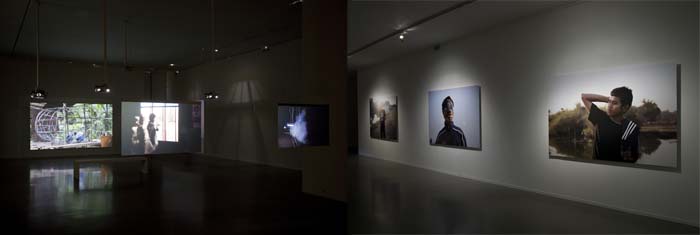
Apichatpong Weerasethakul Exposition Primitive, 2009. Musée d’Art moderne de la Ville de Paris. Photo : Thierry Langro.
Now let’s talk about the second high point of the documentary, the 1960s and 1970s, where political words again had pride of place.
In those years of struggle, the avant-garde programme, involving a certain political effectiveness, seemed to have won out and a lot of very big films with a clear message were duly produced, and they excluded art from the issues they dealt with. Documentary film was thus fuelled by a deteriorated legacy from the avant-gardes, advocating a cinema for one and all that was very clear. A lot of people, like the workers in the Medvekin group, learnt on the spot how to use a camera. What was at stake above all was getting a message across. It was craftsmanship in a state of emergency. This brought about a closure of the genre, which went so far as to be very stoutly opposed to fiction, which, in their view, was in the hands of the capitalist imagination. We should also mention the British cinema of the 1950s, the famous cinema of scientific observation with those horrible things like watching the development of a child at the age of 7, 17, 27… But it’s not very interesting.
How do you see Godard’s case, when he started producing documentaries in the early 1970s?
People always say that Godard had a documentary approach when he made fiction films like La Chinoise, but I’m basically pretty sure that he doesn’t really like that. The moment when he started making documentaries tallies with a moment when he was being badgered by the desire to escape from the burden of being an artist. He wanted to get rid of himself, though he didn’t really succeed. For me he’s not a documentary maker at all, he’s just a brilliant cook who treats his ingredients with the greatest respect.
One of the distinctive things about Godard is that he worked for television, which would be unimaginable today.
At the time, the ORTF television organization was there to deal with the avant-garde programme! It’s very confusing. At the very moment when the various struggles were dying down in the mid-1970s, there were plenty of people involved in the cinema, but no more jobs: television made its appearance and was there for everyone. As Serge Daney wrote in Le salaire du zappeur, there was possible room there, which was not so awful. On the other hand, experimental film found itself up against the wall of commercial cinema, and did not for its part have access to television, so it built a fortress for itself.
Let’s come to the present-day situation. Nowadays, a lot of visual artists are attracted by the means and imagination of film, and the reverse is also true. How are we to appraise this toing and froing?
These days, developments are happening on both sides. Since Documenta X in 1997, and even since Chantal Akerman’s exhibition at the Jeu de Paume in 1995, something really got going: film-makers had access to exhibition venues. Where art was concerned, there was a certain distrust: up until the mid-1990s, no artist was dealing with the documentary issue. The points of reference were also blurred by people like Harun Farocki, who regarded themselves as film-makers and not artists. This latter often recounts how he has two types of problems: replying, during discussions, to questions put by film people which he finds stupid, and answering questions put by art people, which he doesn’t understand. The break between these two worlds is still significant: visual artists like Ariane Michel, Clarisse Hahn and Marie Voignier never went to film school and have somewhat sketchy film references. Because filming costs have become lower and because it has become easier to handle the new tools involved, they have managed to get a foothold in cinema. As far as film-makers are concerned, they are looking for economic alternatives in galleries, which are snapping up their objects without really knowing what to do with them—one example being Marian Goodman who is working with Pedro Costa and Wang Bing, two film-makers who are involved with documentaries.
Are we then to think that by thus exhibiting in art centres and museums, documentary film-makers are renewing the way they see things, or that works are losing their force in them?
I’m very doubtful about these documentary people who venture into art, from Kiarostami to Atom Egoyan, even if their not very good exhibitions in no way discredit their film object. They’re trying to hang their works but they’re not acquainted either with the history of sculpture or with that of video, and in a lot of cases they’re reinventing the wheel. Their interest is above all economic. But after all, it doesn’t much matter to me if the exhibition of Apichatpong Weerasethakul at the MAMVP (City of Paris Museum of Modern Art) failed to knock us off our feet: it enabled him to produce his “Palme d’Or”, and that’s what really matters. It’s possibly difficult to believe, but Akerman has huge trouble funding her films. The same goes for Oliveira. But it has to be acknowledged that the art world also has to do with fantasy, for them. Chris Dercon was recently telling me that he wanted to show a film by Straub and Huillet about Cézanne alongside a Cézanne canvas. I told him I found his idea idiotic. But he reposted that when Straub found out about it, he had tears in his eyes: for them, entering the museum space is like returning to that initial wound I was talking about to do with Vertov, towards that art they have been deprived of. It’s an old, very ancient pain: in all quality films, you can detect this renunciation, this vow of poverty. And suddenly riches come their way!
You describe this poverty as ethical and aesthetic, but also, in the strict sense, as a lack of means?
At the FID, one day, I decided to put fiction and documentary in the same competition: Weerasethakul versus Patricio Guzman. This latter, a great Chilean director, told me: “You have set a trap for us, it’s not possible to judge the two at the same time because fiction has more money than we do”. I replied: “My fictions are worth fifty times less than your films!” He can raise budgets of 700,000 euros, when I’m showing full-length films costing 12,000! But there’s still a monastic Puritanism attaching to this field of art, you can’t get rid of it. And with this poverty there comes a moralism which still distrusts the space of art and the ambiguities that go with it.
How, on the other hand, do you analyze the gradual inroads made by visual artists into film?
Art people aren’t afraid, even if they, too, produce poor objects. Clarisse Hahn and Noëlle Pujol are not afraid of artistic luxury. These young artists do not know much about the documentary, but—and this is more important—they know how to dissect Coppola. This gives them a richer vocabulary than if they were nurtured solely on Chris Marker, Johan Van der Keuken and Frederick Wiseman: cinema plays more with cinema.
After years of indifference, how do we explain that so many artists are grappling with the issue of documentary film? What are they looking for in this arena that art could not offer them?
I don’t say this with any confidence, but I get the impression that what excites them is the possible access to a greater complexity, a desire for wealth. For years, in the 1980s and 1990s, documentary film was decayed by the cancer of narcissism. The tools had become so simple that people found themselves in front of just one possible subject: themselves, or their grandmother. Luckily, we have got rid of all that. What is offered today is the world. Artists describe it in hugely different ways, in a patchwork of very varied propositions, and this is what really interests me. All these films have a very low budget, between 2,000 and 30,000 euros, something which no diehard documentary-maker would want. This may be positive: film is the only art where everything is visible, even and above all money.
The generation of artists like Huyghe, Parreno, and Gonzalez-Foerster was a pioneering one in its connections with cinema. How do you rate their filmic objects?
I have a great deal of respect for their work. For them, a film is an opportunity, each and every time, to hone an issue. I greatly appreciated the strategy behind Zidane, made by Philippe Parreno and Douglas Gordon, because they really thought about the three-part logic: production-filming-distribution. Go and see that DVD at the FNAC on display at the end of the aisle, that’s something avant-garde!
Why do experimental film-makers remained confined within their own boundaries without taking part at all in this discussion?
The field of experimental film reckons it has suffered enough as it is and it doesn’t want to open all the sluice gates. If they open up, they fall apart. In any event, I find their present-day production very academic.
Are these interventions by visual artists in the documentary field giving rise to a renewal of the genre?
There’s no renewal going on, just a sharpening. With a certain subtlety, these people are introducing ambiguity, sophistication, modesty, and a real power to surprise people. Above all, they are confident in the fact that film talks more than one might think. As for the strict tradition of the documentary, it is nowadays confined to TV discussions about the death penalty and pollution. Fortunately, there are film-makers like Arnaud des Pallières who know what complexity is. Art circles tend to think that complexity is Johan Grimonprez, whom they seize upon as if he were something wonderful: I personally find that a bit cute, it’s just sophistication within easy reach; it’s brilliant, but it leaves me cold. For me, simplicity of means leads to a greater complexity of thought.
You like talking about the idea of idiomatic films. Do you think French artists have a particular way of looking at things?
The specific thing about French films has always been a very developed art of filming words, from Jean-Charles Hue to Marie Voignier.
If we compare these visual artists to documentary heterodoxy, what do they contribute, because they often send reality off towards a kind of dream-like place, like the Pont du trieur, by Charles de Meaux and Philippe Parreno, which we might describe as “documensonge”, which roughly means “docu-mendacity”?
I would tend to use the word strangeness, or something magical. In his Chronique d’une femme chinoise, Wang Bing films a woman who describes her life in a re-education camp. The camera never stops, even when she goes to pee, and all of a sudden when night has fallen, we find ourselves looking at a dark screen. It’s awesome. It’s as if the centre of the whole film were this particular moment when you no longer see anything and you hear people talking. For me, it’s a kind of magic without poetry, it’s the blackness of horror. A horror that can be brought out when you no longer see anything on the screen. That woman is the night of history.
- Partage : ,
- Du même auteur : Conversation avec Anri Sala,
articles liés
Claire Staebler
par Patrice Joly
Arnaud Dezoteux
par Clémence Agnez
Interview de Laura Gozlan
par Suzanne Vallejo-Gomez
